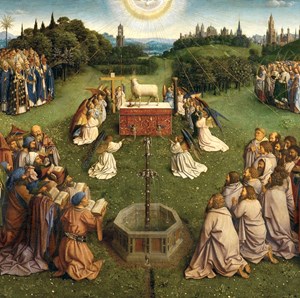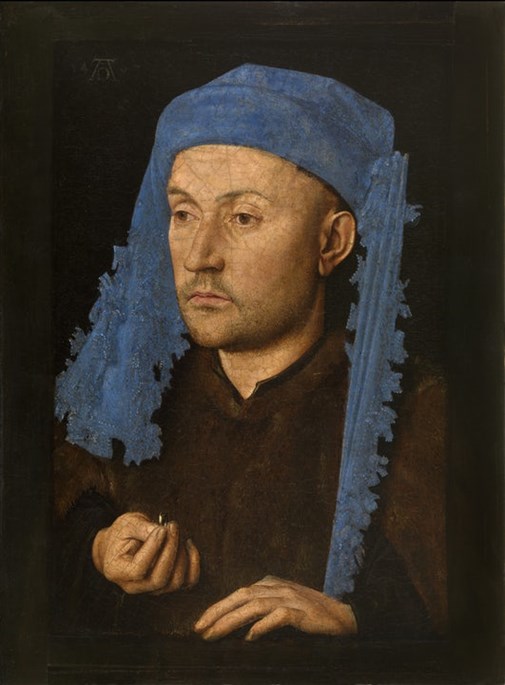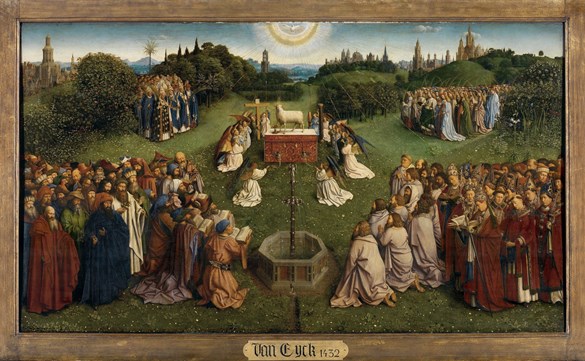
Worldwide, only approximately twenty works by Van Eyck have been preserved. Quite exceptionally, over half of these will travel to Ghent in 2020 for the exhibition ‘Van Eyck. An optical revolution’ at the Museum of Fine Arts (MSK). In what promises to be an unmissable, tour de force of an exhibition, the world of Van Eyck and his revolutionary gaze will be brought to life like never before.
Image: Van Eyck, ‘The Adoration of the Mystic Lamb’ (1432, St Bavo’s Cathedral, Ghent), fragment
Worldwide, only approximately twenty works by Van Eyck have been preserved. Quite exceptionally, over half of these will travel to Ghent in 2020 for the exhibition ‘Van Eyck. An optical revolution’ at the Museum of Fine Arts (MSK). In what promises to be an unmissable, tour de force of an exhibition, the world of Van Eyck and his revolutionary gaze will be brought to life like never before.
The centrepieces of the exhibition are the outer panels of ‘The Adoration of the Mystic Lamb’. These were restored in the MSK by the Royal Institute for Cultural Heritage between 2012 and 2016. In a highly exceptional loan they will return to the museum in 2020, where they’ll be united with other works by Van Eyck for the very first time.

Jan van Eyck, Portrait of a Man with a Blue Chaperon, c. 1428-30 (Muzeul National Brukenthal, Sibiu, Romania)
To contextualise the optical revolution he inspired, Van Eyck’s paintings will be shown alongside works by his most talented peers from Germany, France, Italy and Spain. ‘Van Eyck. An optical revolution’ is a once-in-a-lifetime experience and one of the absolute highlights of Ghent’s 2020 Van Eyck theme year.
Between the court and the city
Jan van Eyck was court painter for Philip the Good, Duke of Burgundy (1396-1467). The flamboyant duke and his entourage surrounded themselves with the best artists. At the same time, the Flemish cities of Ghent and Bruges were prospering as trading centres. Wealthy merchants and politicians mirrored the pomp and circumstance of the courts and were in turn buyers of luxury goods. This was Jan van Eyck’s creative environment, between the court and the city, between art and métier.
The pinnacle of Late Medieval art
Van Eyck distinguished himself from his peers and triggered an optical revolution. With his matchless technique, scientific knowledge and unrivalled observational skills, he elevated oil painting to unprecedented heights and determined the future course of Western art. Never before had a painter made reality so tangible: all that seems to be missing from his portraits is his subjects’ breath, while his landscapes reveal the world in all its facets. Van Eyck trained his eye on the tiniest details before casting it wide again to create unforgettable panoramas.
His masterpiece, ‘The Adoration of the Mystic Lamb’ (1432, St Bavo’s Cathedral, Ghent), bears witness to all three of these qualities. The restoration of the outer wings of the altarpiece will play a central role in the exhibition. Undertaken by the Royal Institute for Cultural Heritage (KIK), the project commenced at the Museum of Fine Arts Ghent in 2012. Visitors will have the opportunity to get close to the work and admire the spectacular results.

Van Eyck, ‘The Adoration of the Mystic Lamb’ (1432, St Bavo’s Cathedral, Ghent)
In dialogue with Van Eyck’s contemporaries
In order to contextualise Van Eyck’s optical revolution, his paintings will be shown alongside works by his most talented contemporaries from Germany, France, Italy and Spain. These artists also moved in exalted circles and received prestigious commissions. The exhibition focuses on the artistic similarities and differences between their works, thus delving deeper into the historical context in which they were created.
‘Van Eyck. An optical revolution’ unravels the myths about the artist and considers his technique, his oeuvre and his influence from a fresh perspective. This exhibition will awaken a sense of wonder among visitors, comparable to that which people would have felt when they saw his works for the first time: a once-in-a-lifetime experience.
A first peek…
The exhibition in 2020 brings around 80 late medieval works to Ghent. Painting, miniature art, sculpture and drawings are placed next to and opposite each other to bring the medieval world of Van Eyck to life.
Van Eyck - An Optical Revolution
1 February, 2020 - 30 April, 2020
Museum of Fine Arts, Ghent, Belgium

ArtDependence Magazine is an international magazine covering all spheres of contemporary art, as well as modern and classical art.
ArtDependence features the latest art news, highlighting interviews with today’s most influential artists, galleries, curators, collectors, fair directors and individuals at the axis of the arts.
The magazine also covers series of articles and reviews on critical art events, new publications and other foremost happenings in the art world.
If you would like to submit events or editorial content to ArtDependence Magazine, please feel free to reach the magazine via the contact page.